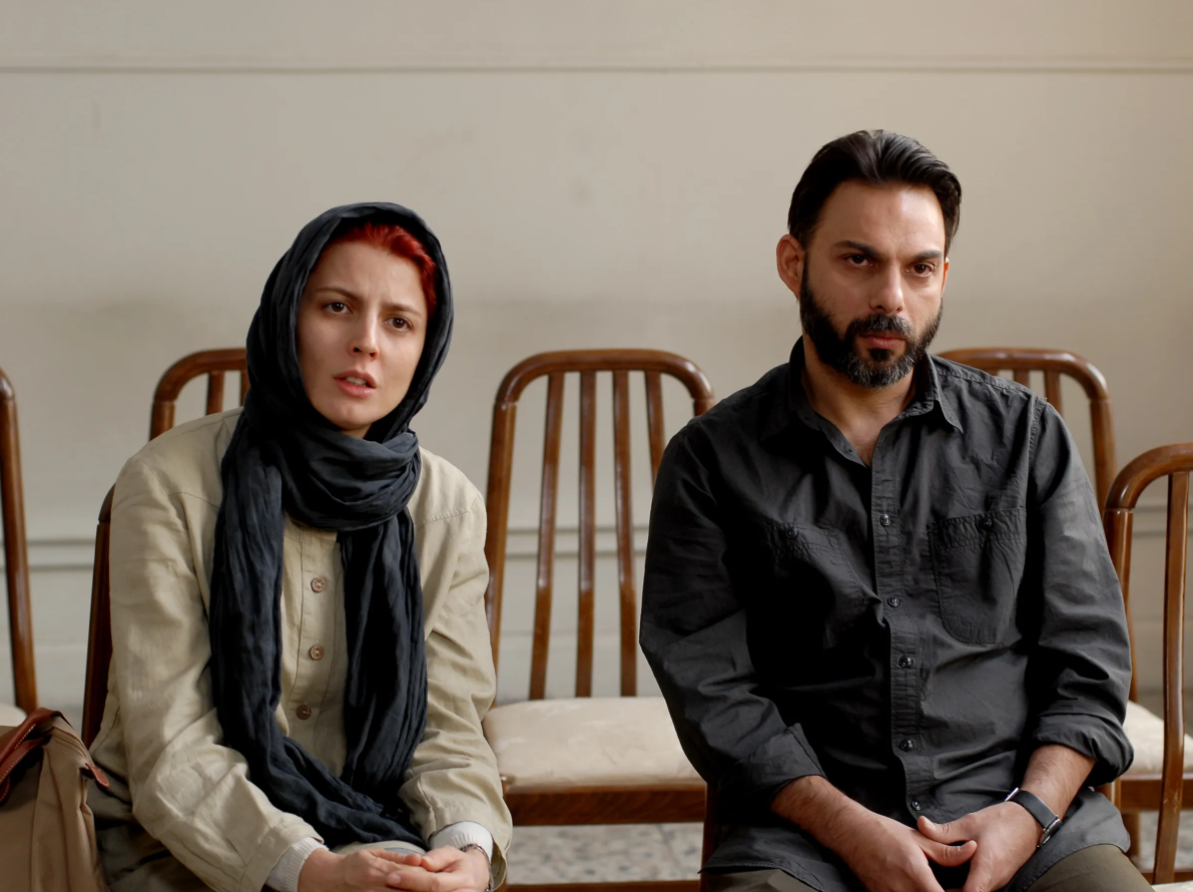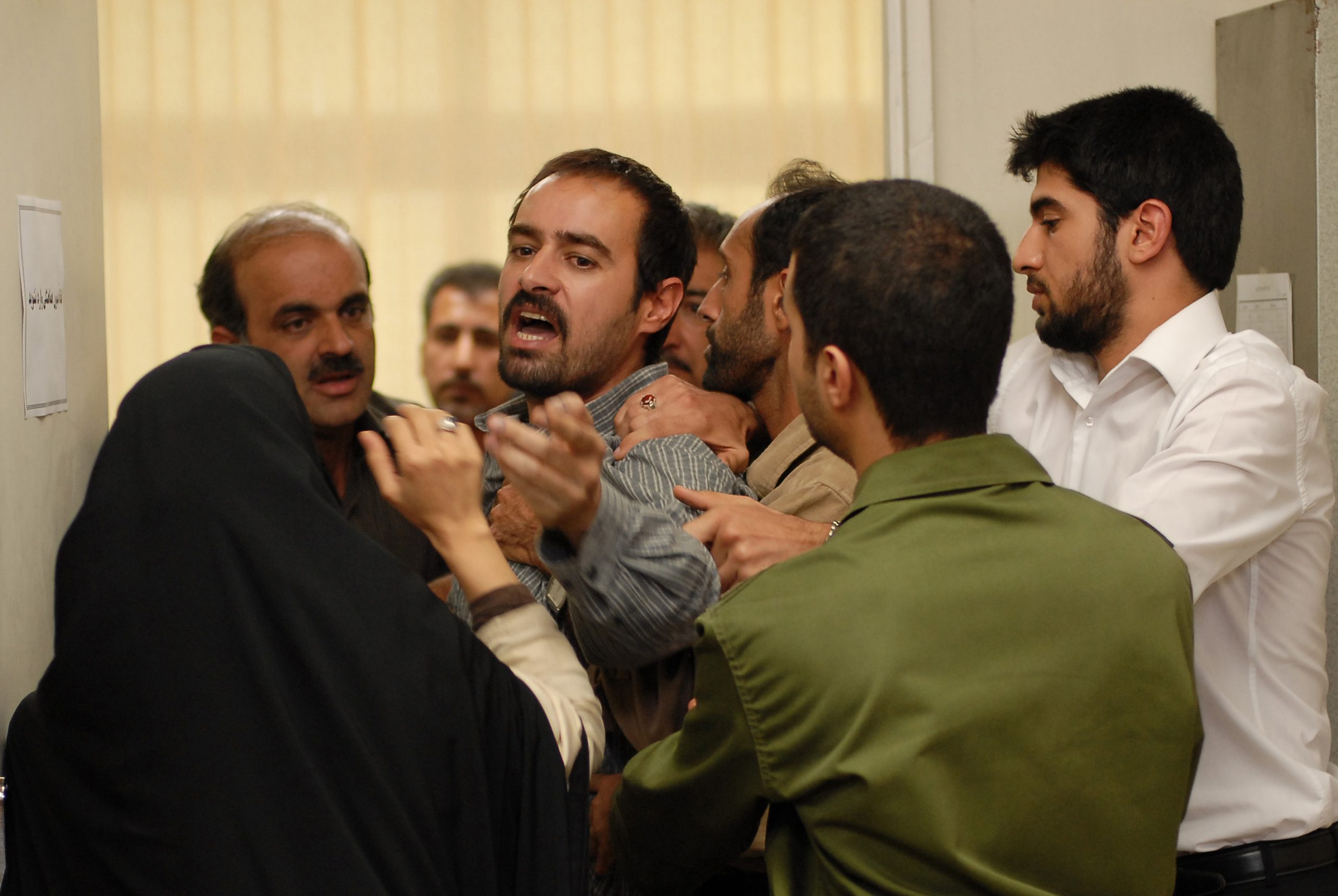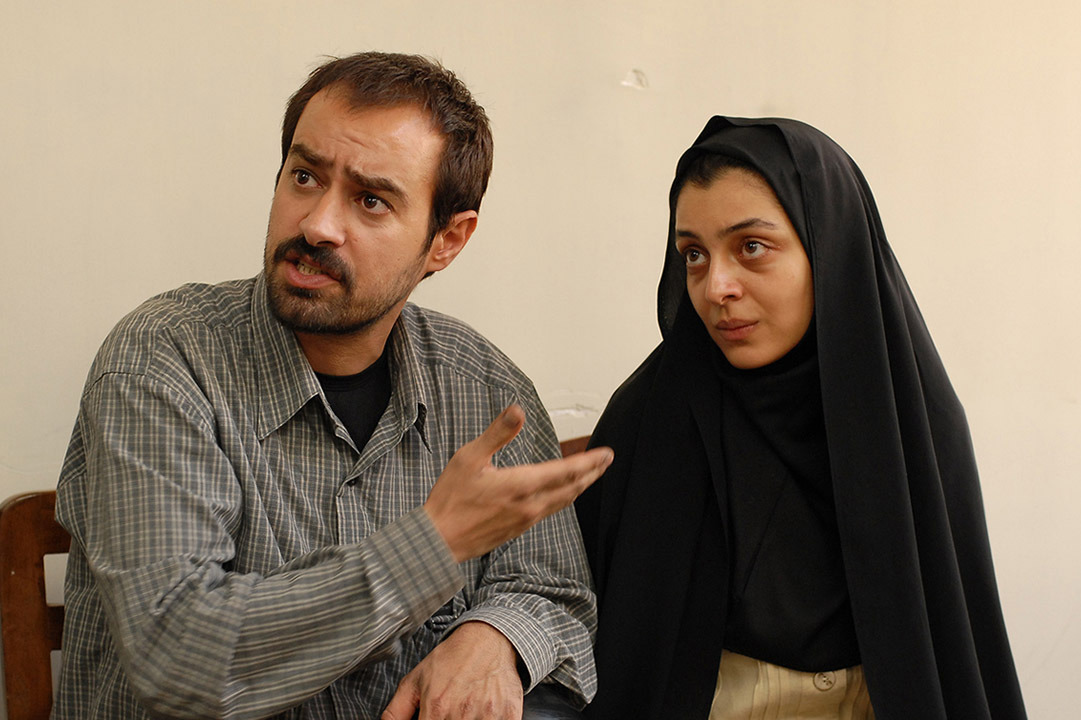
Director: Asghar Farhadi
Wrtier: Asghar Farhadi,
Stars: Payman Maadi Leila Hatami Sareh Bayat Shahab Hosseini Hamid Farokhnezhad
Summary: A married couple are faced with a difficult decision - to improve the life of their child by moving to another country or to stay in Iran and look after a deteriorating parent who has Alzheimer's disease.
As one of the most comprehensive methods of film critique and analysis, the Neo formalism critique of Bordwell and Thomson has a great deal of emphasis on the narrative and stylistic elements of a film. To consider the narrative elements, first of all, presenting a definition of narration could help us to fully understand the topics. The narration could be recognized as a chain of cause and effect that occurs at a specific time and location.

in Farhadi’s works, narrations are close to the classic film narration principles that its pinnacle could be seen in reviewing the cause and effect relationships of his work. The beginning of the cause and effect relationship could be seen in the very first of the titling of the A Separation film. the copying machine that just like the poor box of the About Eli’s first scene, provides a symbolic and important for the whole film. I see some ID cards duplicating. In the meantime, Morteza’s ID card (Hamid Farrokh Nezhad) and Mozhdeh (Hedye Tehrani), create the first connection line between Farhadi’s works. The empty and deceitful life of the Fireworks Wednesday‘s couple that survived for a couple of days with the lies of the Rouhi (Taraneh Alidoosti).

At the beginning of A Separation, we could see a stage that A Separation could be considered as a continuation of the film. These cause-and-effect relationships are important to understand A separation as an ultimate manifest of Farhadi to induce the separation concept in his work record. The relationships begin with the introductory titling by creating an intertextual relationship with Fireworks Wednesday and the more the movie advances, the more strongly they are revealed.
The first scene of court in the analysis of the A Separation is of great importance. the audiences are introduced as the first and last judge of the film by placing the camera in the judge’s point of view. Here, we are faced with one of the most important topics in the film narrative analysis that is somehow representative of the film’s important topic of the narrating that is transferred to the audience through information scope and information depth by the narrator. However, who is the narrator of A Separation?

In A Separation The film’s narrator is going back and forth between the first-person narrator with a limited information scope and the third-person narrator with almost an unlimited information scope. In the first scene, the first-person narrator is introduced by placing the camera in the POV angle. But, in the whole movie, we are faced with an impartial third-person narrator that tries to present an impartial narration of the various film’s characters to its audience by maintaining a certain distance to judge as fairly as possible. Regarding the review of the film’s information depth, we must say that although the film begins with the judge (audience)’s point of view that the narrating is considered a psychological mentality, the film as a whole is on an objective level with an impartial view to create a fairer judgment. The first scene of the film is significant because it has a role in expanding the fundamental concepts of A Separation. Additionally, by exploring the similarities between the screenplay of Farhadi with that of classic films, we could understand the different principles of Asghar Farhadi in the film introduction:

In the first plan, the film introduces the location, the time, and both main characters. The location of the film is related to contemporary Iran. However, the time introduction is transferred indirectly through Simin’s motivation that is one of the main characters of the film. Simin is willing to migrate abroad and when the judge asks the reason for migration, we could understand the film’s occurrence time implicitly: the Year of 2009, an important year in the political and cultural events of Iran that Farhadi describes through Simins’s motivation of migration. on the other side, we have Nader (Payman Maadi) that in his own words could not migrate in these situations for 1001 reasons that the most important one is his father’s Alzheimer’s. The important reason that is gone by the end of the film when his father passes away, but there are still untold 1001 reasons that ultimately lead to the occurrence of the film’s title: A Separation. By expanding the first and the last scene of the film, we could achieve our main analytical thesis expansion which is the concept of separation.

A Separation begins with Nader and Simin’s fight in the judge’s room and when they exit the room and transfer the power to Termeh to choose the person that she prefers to live with (in other words, by what lifestyle), it is ended. As if all the events that are placed between these two scenes, not only help to improve the situations, but when their daughter enters an erosive quarrel, everything becomes worse and more bitter. In other words, it could be stated that although Farhadi’s characters like About Eli’s Ahmad prefer a bitter ending to an endless bitterness, Farhadi himself emphasizes an endless bitterness as the author of his works that surrounds the quantity and the quality of the world of his people. The circular narration that we are seeing in A Separation, has the most important role to induce the emptiness in Farhadi’s works. An emptiness that ultimately leaves no way but loneliness and separation. Dariush Shaygan, in his book (Asia Confronts the West), writes about tracing the historical course of nihilism in the West: In the moral context, nihilism is attributed to opinions that deny the distinction between good and evil (Shaygan,1980, p13 ). According to the definition, we could discuss the nihilism in Farhadi’s works from a different aspect that its culmination is seen in A Separation. At the beginning of the film, Farhadi leaves the judgment to the audience, but during the film, he continues his drama in a way that the only impossible thing in the ending is to reach a certain judgment regarding various events and categorizing characters as rightful and wrongful. A nihilism that was referred to in the film’s narrative form through expanding the first and the last scene now is discussed from a different aspect. The ethical nihilism in A Separation puts everything in a haze of ambiguity that Farhadi wants. Ambiguity about the impossibility of achieving a decisive judgment about the rightfulness and wrongfulness of the film’s characters.

Then, we enter Simin and Nader’s home. The second important location and somehow the main location after introducing the first film’s location, namely the court. a few workers are trying hard to carry down a piano that Simin has sold it. A symbol for plundering the artistic assets of a family turns into a context to introduce the most important personality characteristic of Simin. The workers are complaining about the number of stories that they were told to begin with and now they are demanding more money. The request that Simin accepts with the least bargaining as long as they make way for her so that she can continue on her path. This personality characteristic of Simin i.e. giving up against reasonable and unreasonable demands of others is a fact that puts her right against Nader. When Simin goes to the bedroom to get the money and satisfy the workers, the cause-and-effect relationships begin that create an uncontrollable tsunami. However, when Termeh knows that her mother is getting the money and when she refuses to talk when his father is fighting with Razieh over picking up the money from the bedroom, the causal relationship at beginning of the film is slightly challenged.

Here, we should also survey one of the main differences of Farhadi’s works from the classic cinema principles. As much as in the classic works, the factor that creates the initial motivating incident at the end of the first third of the film is hard and big, In Farhadi’s works, there are simple and seemingly insignificant daily events that create great catastrophes in a Hitchcock process. Emphasis on simple daily factors in making the world of drama as effective as possible is the effort that Farhadi makes to reach the peak of realism in his works.

Nader and Razieh fight over the money to maintain the father and housework (300 thousand Tomans per month) is the most important cultivation that is done in this part of the film for two purposes: One is the transformation of financial issues into the most important factor in the conflict in the middle of the film, and the other is the introduction of Nader’s character who, in stark contrast to Simin, can oppose the demands of others, even the right ones which creates the most important foundation of his character in the sequel. Creating purposeful cultivations, which are not easy to understand due to Farhadi’s inclination towards realistic cinema, further leads to perceptions that ultimately help to better develop the cause-and-effect relationships of the film. Creating cultivation that we can see in the entity of Nader’s character in several scenes, and in a way, by relying on the technique of similarity and repetition, is interpreted in different ways; whether in the scene of Termeh getting gas in the gas station that induces one of the most fundamental life principles to him and whether in all the quarrel scenes, that according to his words, he will not give any money to anyone until he is proven guilty. This fundamentalism of Nader puts him in stark contrast to a reformist character like Simin, who often tries to solve the problem in which she is caught by paying for it.

The end of the first introduction sequence of the house confronts us with Farhadi’s most important arrangement, which is constantly repeated throughout the film to perfectly convey the main concept of the film to the audience: the use of objects and scene elements in various frames that Along with placing the camera in the frames of the house, it instills the concept of separation in the best possible way to the audience. The differences that we discussed at the narrative level now show themselves in the best possible way in the stylistic elements as well.
One of the features of Farhadi’s works is the emphasis on the reaction of the characters, especially in times of silence. Something that can be interpreted as the creator of meaning in A Separation.

For example, in one of the most important scenes of the film, in which Ms. Ghahraei (Merila Zarei) is giving the number of a gynecologist for ultrasound, we are confronted with 4 characters present on the scene (Ms. Ghahraei, Razieh, Somayeh, and Termeh) and an absent character (Nader in the kitchen) Which is located outside the frame. Not seeing a specific reaction from Nader in this scene is something that, by limiting the audience’s range of information, creates suspense and ultimately surprises in the continuation of the story. By not seeing Nader in this scene, the audience’s level of information is limited to the characters present in them. We see the scene. Interestingly, the dialogues of this scene continue to form many important scenes of the film and many basic possibilities of the drama. For example, Ms. Ghahraei’s inquiry from Somayeh in the corridor of the court about the subject of her painting or Termeh’s lie about that she told her father about the exchange of the doctor’s number, and finally, the surprise that the audience encounters in the scene of Nader teaching the mathematical profit and loss to Termeh, and realizing that Nader knew about Razieh’s pregnancy from the very beginning. all of these narrative perceptions are due to the cultivations that Farhadi conveys to the audience in this important scene both at the level of narrative elements and through stylistic elements (space outside the frame). somehow the secrecy, which is one of the main principles of Farhadi’s works, could be seen in his stylistic elements in the best possible way. The culmination of which is seen in hiding the scene of Razieh’s accident. One of the differences that can be seen in the narrative level between Farhadi’s works and the classic cinema films is hiding the inciting incident and a kind of initial turning point at the end of the first third of the film which begins with About Eli continues with A Separation and The Past and climaxes in The Salesman. Hiding the inciting incident initiates various possibilities, interpretations, and sometimes judgments in which Farhadi expresses his themes. A judgment that Farhadi remembers in the first plan of A Separation is intensified by hiding Razieh’s accident scene at the end of the first third of the film because not seeing the accident scene leaves room for the various possibilities that form in the middle of the story. Somehow by limiting the scope of the audience’s information, the necessary ground is created for the final surprise and disclosure of the accident by Razieh for Simin. So here we can understand the function of eliminating the accident scene: creating a suitable ground for proposing different interpretations to form a judgment that has been placed on the shoulders of the audience from the very beginning. If the audience was informed about the accident scene, a certainty would have been created in the different events of the film Which would have taken away the possibility of different judgments and interpretations from them. Something that did not match the original contract of the film, which is to place the audience on the judging chair.

Also, in A separation We are witnessing an inter-class and intra-class struggle. In the meantime, it is very important to pay attention to Nader’s job. Nader is a bank employee. A job that raises the most important symbol in inter-class discussions, namely money, and capital. All the inter-class legal litigations of A Separation revolves around ransom money. It is money that can save Hojjat’s miserable life (Shahab Hosseini), and in the meantime, his rival is someone who knows very well the value of money in contemporary Iranian society. Nader, who is not willing to give up on even the slightest right (such as Termeh’s tip to the person in charge of the gas station) in this regard. The result of the efforts of these typical representatives is fights and conflicts that represent many social problems of contemporary Iranian society. Poverty, as the biggest social problem in contemporary Iran, is the main basis for various inter-class conflicts. Nader and Simin’s separation from each other can be typically generalized to the internal and external class separation and rupture that has engulfed contemporary Iranian society. A rupture that can certainly be faced with many threats that potentially threaten different socio-political levels of contemporary Iran.

A Separation Could be seen as the most coherent film of Farhadi. Because the formation of each event (cause) creates an event (effect) that is formed from their heart in dialectical relationships such as drama effects (suspension, surprise, and mystery). the proof of this is A Separation’s screenplay nomination in Oscar in the category of The Best Original Screenplays of 2012 that is unique in the history of Iranian cinema. and its reason is both reliance on the principles of classical dramaturgy considered by the Oscars and the disconnections in the structure of A Separation’s screenplay. disconnections such as hiding the first turning point, which is created to develop a suitable ground for different interpretations. Something that brings Farhadi’s works very close to the narrative principles of the mystery genre, in which the film’s detective is no one other than the film’s audience.
A Separation movie ending explained:
In the closing scene, Nader and Simin have re-filed for divorce at the family court. The judge asks Termeh who she wants to live with after permanently separating them. Although she claims to have made a decision, she requests that the judge instruct her parents to wait outside before she tells the judge.
In A Separation, who did Termeh choose?
The audience gets to decide who they wish to use.
(Hints: Termineh always opted for her father since she knew her mother would never abandon her.)





That was a great movie. I really enjoyed!
My first Iranian movie, and I have to admit that it did not let me down.
I’ve been attempting to watch movies in different languages, such as French, Italian, and now this. It’s undoubtedly a unique film that, to some, may seem a little drawn out. If you’re looking for a high-caliber film, this would be one of those, but you’ll need to have some patience.
However, it gets a 4/5 from me!
Love to Iran from India!
An excellent movie.extremely well made.Strongly developed characters, with the actors really getting beneath the skin of the characters, especially the couple’s daughter.She portrays the immense turmoil and uncertainty in her head with such brilliance.a must-see.
A Separation delves into topics of justice, class, and family, and I found it to be a very intelligent and thought-provoking movie. The movie is about a middle-class couple in Tehran who are divorcing each other. Nader, the husband, demands custody of the child and accuses Simin of planning to take their daughter to live abroad. The couple’s journey through the Iranian judicial system and their own personal challenges are chronicled in the film.
The performances throughout the movie, especially Shahab Hosseini’s as Nader and Leila Hatami’s as Simin, really won me over. Additionally, Farhadi does a fantastic job writing the storyline for the movie.